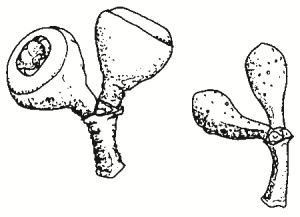Family:
Myrtaceae
Eucalyptus dives
Broad-leaved Peppermint
Other Names:
First Nations Name(s):

Name Origin:
dives — Latin for rich or plentiful, referring to oil in leaves.
Regional Subspecies:
Similar Species:
Sometimes similar to Red Stringybark (E. macrorhyncha), but distinguished by its smaller fruit and distinct juvenile foliage.
Occurrence:
Regional:
Widespread in higher rainfall catchments predominantly east of the Hume Highway.
Australia:
NSW, Vic.
Habitat:
Dry sclerophyll woodland on poor shallow stony soils, on rises.
Habit:
Tree to 20 m high, with shortly fibrous bark shedding in ribbons above. Glossy green adult leaves.
Site Preference:
Well-drained, relatively poor soils on gentle slopes and ridges. Tolerates moderate frost, extended dry periods and wind.
Characteristics:
Fast-growing.
Flowering:
White-cream, mainly Nov-Dec.
Seed Collection:
Throughout year, particularly Nov-Dec.
Propagation:
From seed (± 750 seeds per gram). Optimum germination temperature is 15°C. Seed stratification for 4 weeks, although not essential, enhances germination. Seedlings may not survive in sterile potting mix. Adding local soil or leaf litter to mix should overcome problems.
Regeneration:
From seed, particularly in absence of exotic grasses and weeds, and during wet summers. Coppices vigorously from waist-high stumps.
VALUES:
Shade & Shelter:
Useful medium-level cover in windbreaks. Useful shade due to large crown and low branches. For tree health and regeneration, fencing to exclude livestock recommended.
Wildlife:
Valuable habitat. Flowers are a food source for nectar-feeding birds, mammals and insects. Insect-eating birds attracted. Seeds and fruits food for native birds. Hollows are nesting and refuge sites for a range of birds and mammals.
Timber:
Moderately hard and strong, but not durable. Subject to numerous gum veins. Generally not used.
First Nations:
People with fever exposed to smoke from burning leaves to bring relief. Heat was thought to go from suffering person into fire.
Ornamental:
Attractive specimen for gardens.
Other:
Can be grown and coppiced for foliage useful for cut foliage market, and for distilling for cineole and piperitone oils. Oils used in mineral flotation or as solvents. Piperitone oils used in menthol (liniments and mouth washes) and thymol, a fungicide. Can be continuously cut for years, suckering vigorously. Leaves produce yellow dye with alum as mordant.
